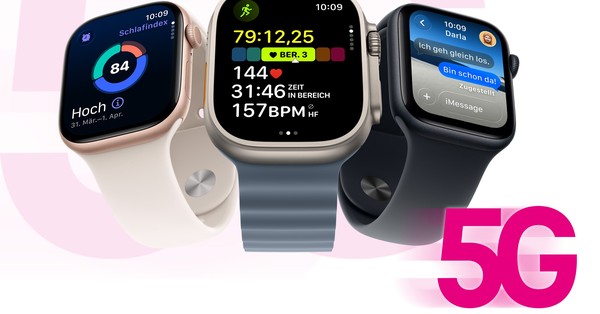5G RedCap wearables launch in Germany with Deutsche Telekom and Apple
Deutsche Telekom has launched 5G connectivity for the latest Apple Watch models using 3GPP RedCap over its 5G standalone network, marking a strategic first for Germany’s wearable market.
Launch details and availability
Deutsche Telekom is currently the only German operator enabling 5G on the new Apple Watch lineup, leveraging its 5G standalone (marketed as 5G+) footprint and Reduced Capability (RedCap) functionality. The service runs across current MagentaMobil and Smart Connect plans at no additional fee, with simple activation via MultiSIM so the watch shares the user’s mobile number. Where 5G is unavailable, the watch falls back to LTE.
Why 5G RedCap wearables matter now
This is one of the first mass-market RedCap launches tied to a high-volume consumer device, moving RedCap from trials and modules into mainstream adoption. It signals that 5G standalone is shifting from a technology milestone to a commercial differentiator, and that the wearables category is entering a new performance and battery-life phase beyond LTE-M and classic LTE. For rivals in Germany and across Europe, the race is now on to certify RedCap for wearables and expand 5G SA coverage to stay competitive.
What RedCap is and why it fits 5G wearables
RedCap, defined by 3GPP in Release 17, targets devices that need moderate throughput with lower complexity and longer battery life.
RedCap explained: capabilities and benefits
RedCap (Reduced Capability) provides a 5G profile optimized for compact devices. It trims radio complexity—fewer antennas, narrower bandwidths, and simplified scheduling—while preserving key 5G benefits like low latency and tight integration with the 5G core. The result is lower energy consumption and smaller bill of materials versus full eMBB 5G, yet with more headroom than LTE-M or NB-IoT.
Why RedCap suits Apple Watch
Wearables need consistent connectivity, power efficiency, and acceptable uplink for voice and notifications, without the overhead of smartphone-class radios. RedCap hits that balance. It enables better responsiveness for messaging, location, and cloud apps, supports IMS-based services, and extends battery life by avoiding heavy multi-antenna configurations. On a mature 5G SA network, RedCap can also tap evolving features of 5G Advanced as they arrive.
Implications for operators and device vendors
The launch underscores 5G SA as a platform for new consumer and enterprise device categories, not just faster phones.
Requirements and opportunities for operators
Commercial RedCap on a flagship wearable validates the investment in 5G SA cores, RAN features, and policy/QoS integration. Operators will need wide SA coverage, VoNR readiness, IMS optimizations, and seamless LTE fallback to maintain call quality and battery performance. Expect new RedCap device onboarding workflows, MultiSIM/eSIM journey refinements, and targeted plan constructs for wearables and sensor fleets. Competitively, RedCap certifications with leading OEMs and clear SLAs will become a differentiator.
Impact on device and silicon ecosystems
Apple’s move accelerates RedCap roadmaps across chipsets and modules, encouraging broader support from silicon vendors and ODMs. It creates a pull for testing, conformance, and interoperability across diverse bands and power profiles. Expect wearables, industrial handhelds, video wearables, and compact CPE to follow, with Release 18 “5G Advanced” enhancements improving mobility, positioning, and energy efficiency.
RedCap opportunities for enterprise and private 5G
RedCap opens a path for enterprise-grade wearables and compact devices that balance performance and battery life on public or private 5G.
Industrial and workplace use cases for RedCap
Hands-free comms, safety wearables, lone-worker devices, and AR-lite headsets benefit from deterministic performance and long battery life. RedCap on private 5G can deliver better QoS and security than Wi‑Fi in constrained or mission-critical environments, while public–private roaming and eSIM profiles allow flexible deployments across campuses and field operations.
Service models and integrations with IMS and eSIM
Enterprises should look for RedCap-ready device catalogs, eSIM orchestration, policy-based prioritization, and integration with UC/voice platforms over IMS. Operators and integrators can package device management, analytics, and lifecycle support, with APIs for fleet monitoring and incident response. As slicing matures, premium QoS tiers for wearables can align cost with criticality.
Key challenges and what to watch next
Despite the milestone, several technical and commercial gaps remain as RedCap scales.
Coverage, voice continuity, and roaming
5G SA coverage still varies by market and band, and RedCap roaming agreements and device profiles are early-stage. Voice continuity depends on VoNR maturity and efficient fallback to LTE where needed. Operators must tune radio parameters, mobility, and power-saving features to avoid battery drain in mixed-coverage areas.
Standards evolution and device diversity
Release 18 will refine RedCap mobility, positioning, and power optimizations. Certification pipelines will need to keep pace across frequency bands and coexistence scenarios with LTE and Wi‑Fi. Expect variance in device capabilities, which will require clear labeling of supported features and enterprise testing before scale deployment.
Next steps for operators, enterprises, and vendors
Organizations can use this launch to accelerate RedCap strategies across consumer and enterprise portfolios.
Action plan for operators
Audit 5G SA readiness for RedCap at scale, including RAN features, IMS/VoNR, eSIM flows, and policy controls. Prioritize certification programs with leading OEMs, build clear wearables propositions with MultiSIM, and prepare RedCap SKUs for enterprise with SLAs and device lifecycle support. Track Release 18 timelines and plan network upgrades accordingly.
Action plan for enterprises and solution providers
Pilot RedCap wearables for frontline and safety use cases on public and, where available, private 5G. Validate coverage and battery performance in real environments, integrate with identity/MDM and UC platforms, and define QoS requirements for critical users. Include roaming and fallback behaviors in acceptance testing.
Action plan for vendors and integrators
Align product roadmaps to RedCap profiles, publish performance and battery metrics, and support eSIM-based activation at scale. Offer reference architectures for private 5G deployments featuring RedCap wearables and compact devices, with analytics and observability baked in.
Bottom line
Deutsche Telekom’s Apple Watch 5G launch is a watershed moment for RedCap and 5G SA commercialization in Europe.
Why this is a turning point for RedCap wearables
By pairing a top-tier wearable with RedCap on a live 5G SA network, the market now has a visible proof point that 5G can deliver right-sized performance and battery life for small devices. Expect accelerated RedCap adoption, intensified operator competition on SA coverage and certifications, and a new wave of enterprise-grade wearables built for 5G from the start.








































